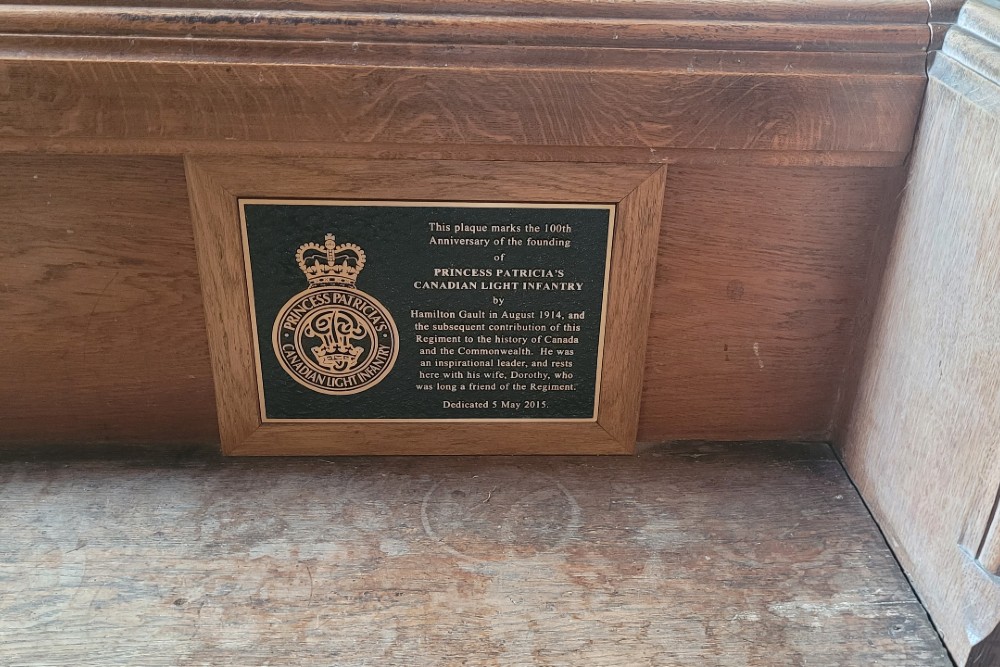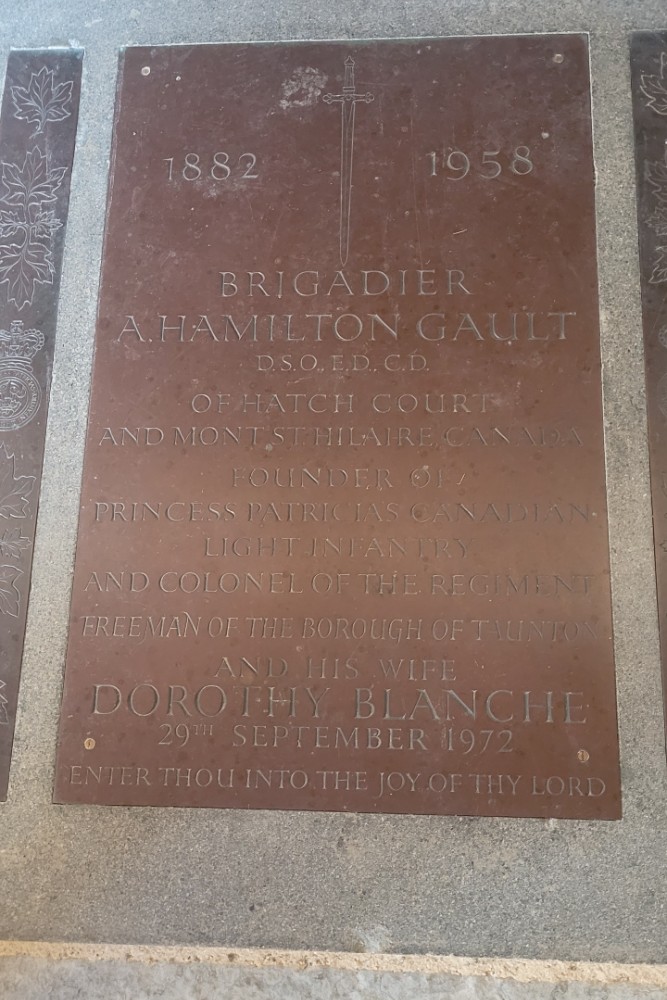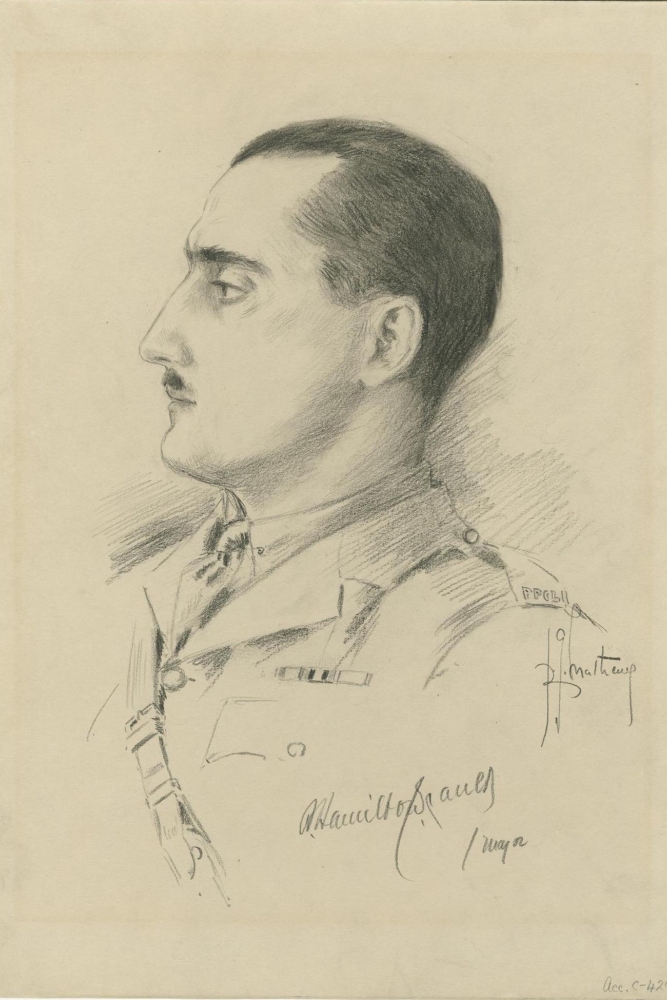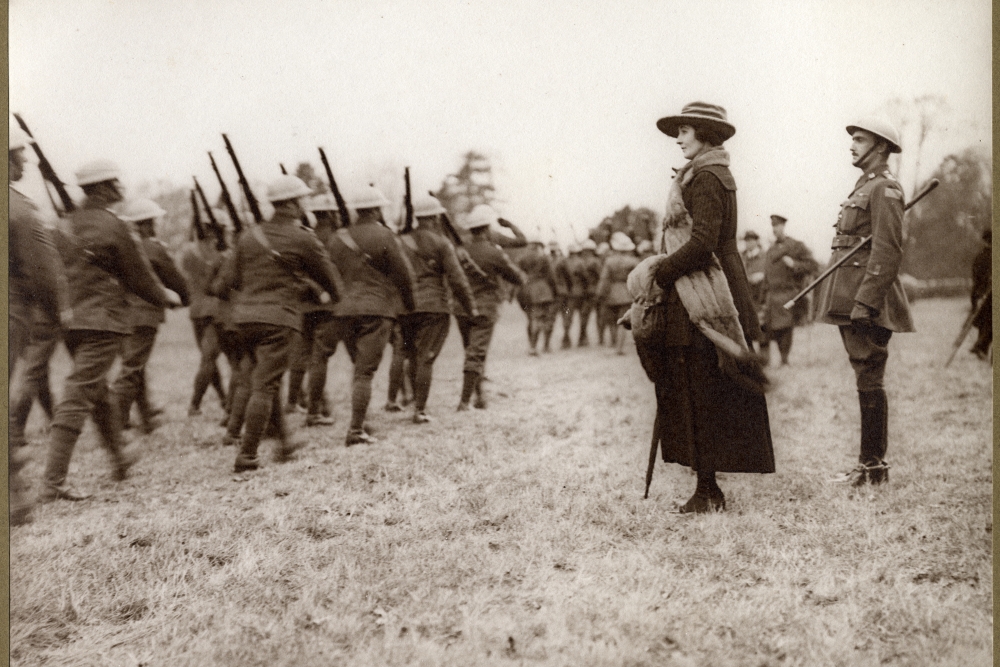Memorial Brigadier A. Hamilton Gault
"1882-1958
Brigadier
A. Hamilton Gault
D.S.O., E.D., C.D.
of Hatch Court
and Mont St. Hilaire, Canada
Founder of
Princess Patricia's Canadian
Light Infantry
and Colonel of the Regiment"
"This plaque marks the 100th Anniversary of the founding of Princess Patricia's Canadian Light Infantry
by Hamilton Gault in August 1914, and the subsequent contribution of his regiment to the history of Canada and the Commonwealth. He was an inspirational leader, and rests here with his wife, Dorothy, who was long a friend of the Regiment. dedicated 5 May 2015."
Andrew Hamilton Gault was born in England on 18 August 1882. He was descended from Scottish-Irish of Ulster who immigrated to Canada from Northern Ireland in 1842 and settled in Montreal. In 1900, at the age of 18, he was commissioned into the 2nd Canadian Mounted Rifles and served with distinction as a subaltern until the end of the South African War in 1901. He was awarded the Queen's medal with three clasps.
After the war he continued military service with the Canadian Militia, eventually becoming a Captain with the 5th Royal Highlanders (Black Watch). The Princess Patricia's Canadian Light Infantry was raised in Ottawa in August 1914 as the result of an offer by Captain Andrew Hamilton Gault, by now a prominent business man, to provide $100,000.00 to finance and equip a regiment for overseas service. The Princess Patricia’s Canadian Light Infantry was founded for service in the First World War on August 10, 1914, and paraded for the first time at Lansdowne Park, Ottawa, Ontario, on August 23, 1914. It was the last privately raised regiment in Canada.
Gault was appointed Senior Major and Second-in Command of the Princess Patricia's Canadian Light Infantry. He was the first Canadian to receive the Distinguished Service Order for gallantry in the field during the First World War when he was wounded while retrieving casualties under fire at St. Eloi on 28 February 1915. He was wounded again at the Battle of Frezenberg on 8 May 1915 and again for the third time at the Battle of Sanctuary Wood on 2 June 1916, ending his field service with the Regiment. Despite losing his left leg, he refused repatriation to Canada and returned to duty as a Staff Officer with the 3rd Canadian Division until the end of the war.
On 28 March 1918, Major Gault was promoted to Lieutenant-Colonel and rejoined the Regiment as Commanding Officer in November. Gault and the surviving members of the Princess Patricia's Canadian Light Infantry left France for England on 7 February 1919. The Princess Patricia's Canadian Light Infantry returned to Ottawa 19 March 1919 for their victory parade, led by Lieutenant-Colonel Gault. For his service in the Great War, Gault was also awarded the Order of the British Empire, the 3rd Class Russian Order of St. Anne with Crossed Swords and the Belgium Order of the Crown. He was Mentioned in Despatches four times and made Honourary Lieutenant-Colonel in 1920.
In 1939, Hamilton Gault was recalled for active duty with the Canadian Army in England and was promoted to the rank of Colonel in 1940 and to Brigadier-General in 1942. He commanded a Canadian Army Reinforcement Holding Unit until ill health forced him to retire later that year. He returned to Canada and his Canadian home at Mount St. Hilaire in Quebec in 1944. In 1947, Gault founded the Princess Patricia's Canadian Light Infantry Association and served as the first National President. He always maintained his connection with the Regiment and gave advice on Regimental matters which were always referred to him. Gault was appointed honorary Lieutenant-Colonel in 1948 and visited the Regiment in Calgary in 1953 and in Germany in 1954. He was appointed the first Colonel of the Regiment shortly before his death 28 November 1958.
The 'Princess Pats' were formed at the outbreak of war in August 1914 and by 19th Aug had a complement of 1,098 volunteers of whom 1,049 had previously served in South Africa or the British Army. The Regiment sailed with the first Canadian contingent to Britain on 27 September 1914 and were billeted near Salisbury Plain and Winchester. On 20th December the 'Pats' sailed for France and became the first Canadian Infantry unit there. The Regiments first major battle was at Frezenberg on May 8th 1915, where a stout defence established their reputation but at a cost of only 150 out of 700 men being available at the end. The Regiment fought in the battles of the Somme, Vimy Ridge, Passchendaele, Amiens Jigsaw Wood, and Canal Du Nord and won two Victoria Crosses.
The Regiment was gain mobilised on 1st September 1939 and sailed for Britain on 21st December. They were inspected by Princess Patricia, their Colonel in Chief for the first time in 21 years. After more than 3 years of coastal defence and training the regiment took part in Operation Husky, the invasion of Sicily and then the invasion of Italy advancing against the German defence lines. In March 1945, they transferred to North west Europe and took part in the Liberation of Holland and Amsterdam. At the end of the war in Europe they were earmarked for service in the war against Japan but with the end of the war in Aug 1945 they were able to return to Canada in October 1945 and demobilized.
In Aug 1950 the 2nd Battalion was allocated to the UN forces to combat the North Korean invasion of South Korea and arrived in Pusan in December 1950, joining the 27th British Commonwealth Brigade.
At the Battle of Kaypong the 700 men of the 2nd Bn. were cut off and surrounded by 20,000 Chinese soldiers but held their position enabling the UN forces to regroup and save Seoul. The Regiment was awarded an U.S. Presidential Unit Citation.
After the Korean War, the Regiment served with NATO in West Germany and on many UN peacekeeping missions including the Serbian/Croatian conflict. The Regiment also served in Afghanistan between 2003 and 2010.
Do you have more information about this location? Inform us!
Source
- Text: Sharky Ward
- Photos: Anthony (Sharky) Ward (1, 2), Richard George Matthews (3), See page for author, Public domain, via Wikimedia Commons (4)
- - Brigadier Andrew Hamilton | Canadian Virtual War Memorial
Nearby
Monument
- Memorial Window Colonel J.M. Chard V.C. - Hatch Beauchamp
- Rolls of Honour St James Church - Curry Mallet
- War Memorial Thornfalcon - Thornfalcon
Cemetery
- Grave Colonel John M. Chard V.C. - Hatch Beauchamp
- Commonwealth War Grave St. Andrew Churchyard - West Hatch
- Commonwealth War Graves St. James Churchyard - Curry Mallet








